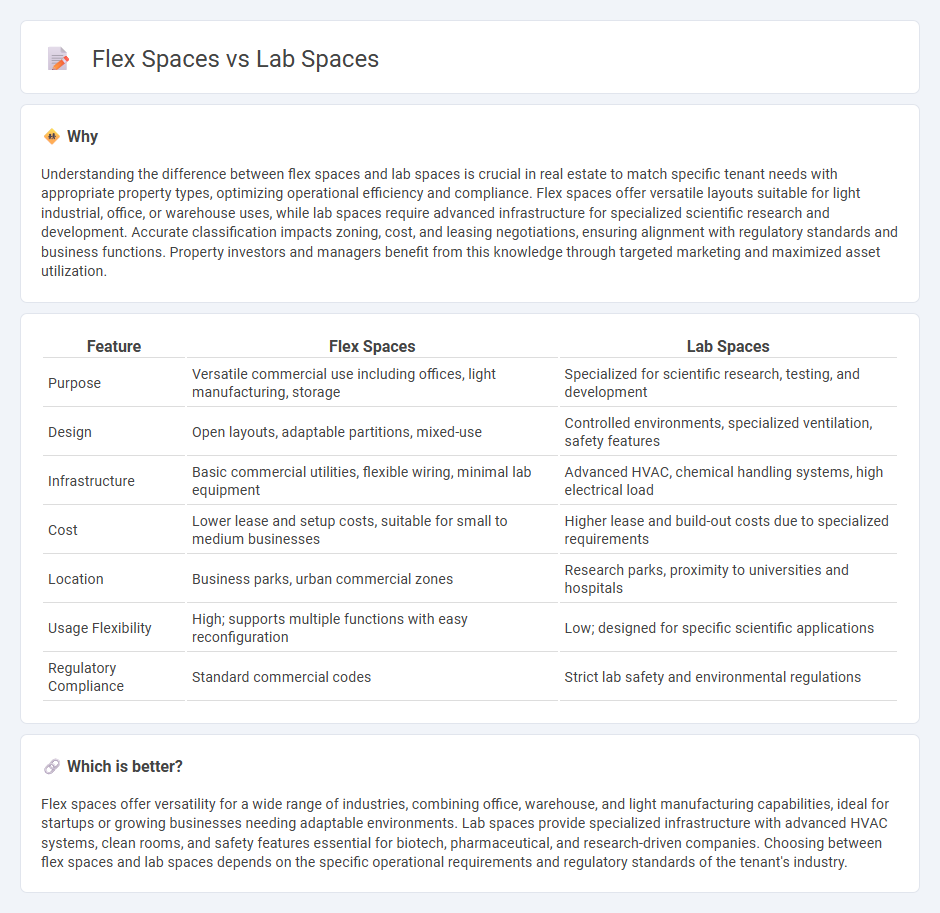
Flex spaces offer adaptable layouts designed to accommodate various commercial activities, providing cost-effective solutions for startups and small businesses. Lab spaces, on the other hand, are specialized environments equipped with advanced infrastructure to support scientific research, development, and testing. Explore further to understand how choosing between flex and lab spaces can impact your real estate strategy.
Why it is important
Understanding the difference between flex spaces and lab spaces is crucial in real estate to match specific tenant needs with appropriate property types, optimizing operational efficiency and compliance. Flex spaces offer versatile layouts suitable for light industrial, office, or warehouse uses, while lab spaces require advanced infrastructure for specialized scientific research and development. Accurate classification impacts zoning, cost, and leasing negotiations, ensuring alignment with regulatory standards and business functions. Property investors and managers benefit from this knowledge through targeted marketing and maximized asset utilization.
Comparison Table
| Feature | Flex Spaces | Lab Spaces |
|---|---|---|
| Purpose | Versatile commercial use including offices, light manufacturing, storage | Specialized for scientific research, testing, and development |
| Design | Open layouts, adaptable partitions, mixed-use | Controlled environments, specialized ventilation, safety features |
| Infrastructure | Basic commercial utilities, flexible wiring, minimal lab equipment | Advanced HVAC, chemical handling systems, high electrical load |
| Cost | Lower lease and setup costs, suitable for small to medium businesses | Higher lease and build-out costs due to specialized requirements |
| Location | Business parks, urban commercial zones | Research parks, proximity to universities and hospitals |
| Usage Flexibility | High; supports multiple functions with easy reconfiguration | Low; designed for specific scientific applications |
| Regulatory Compliance | Standard commercial codes | Strict lab safety and environmental regulations |
Which is better?
Flex spaces offer versatility for a wide range of industries, combining office, warehouse, and light manufacturing capabilities, ideal for startups or growing businesses needing adaptable environments. Lab spaces provide specialized infrastructure with advanced HVAC systems, clean rooms, and safety features essential for biotech, pharmaceutical, and research-driven companies. Choosing between flex spaces and lab spaces depends on the specific operational requirements and regulatory standards of the tenant's industry.
Connection
Flex spaces and lab spaces intersect in real estate by offering adaptable environments tailored for innovation-driven industries such as biotechnology and pharmaceuticals. These spaces often feature modular designs, advanced HVAC systems, and robust infrastructure to support specialized lab equipment and collaborative work areas. The convergence facilitates efficient space utilization, fostering agility and collaboration crucial for research and development activities.
Key Terms
Specialized Infrastructure
Lab spaces require specialized infrastructure such as advanced HVAC systems, chemical fume hoods, and reinforced flooring to support heavy equipment and ensure safety. Flex spaces offer adaptable layouts with minimal fixed infrastructure, allowing easy reconfiguration for various business needs but lacking specialized facilities. Explore how these differences impact productivity and cost-efficiency in your workspace planning.
Adaptability
Lab spaces specialize in accommodating scientific research with fixed infrastructure like fume hoods and specialized ventilation, ensuring safety and precision. Flex spaces offer a more adaptable environment with modular furniture and movable partitions, supporting diverse usage scenarios such as startups, offices, or light labs. Explore how choosing between lab and flex spaces impacts innovation and operational efficiency.
Zoning Compliance
Lab spaces require strict zoning compliance due to specialized usage regulations, including hazardous material handling and ventilation standards, which differ significantly from flex spaces designed for more general purposes such as offices or light manufacturing. Flex spaces often fall under broader commercial zoning categories with fewer restrictions, allowing a combination of office, warehouse, and light industrial activities, making them more adaptable to changing business needs. Explore our detailed guide to understand zoning requirements and ensure compliant facility planning.
Source and External Links
THE SPACE - Offers 12,000-square-foot lab facilities with wet and dry spaces, equipment like biological safety cabinets, and co-working spaces for collaboration.
Innovation Space - Provides over 130,000 square feet of lab space supporting life sciences, clean tech, and advanced materials startups with flexible lease options.
Research Park Lab Spaces - Offers 23 individual 570-square-foot labs with various configurations and access to university facilities at discounted rates.
 dowidth.com
dowidth.com